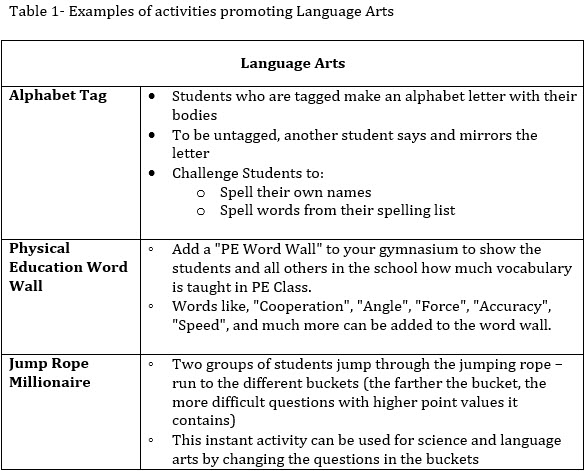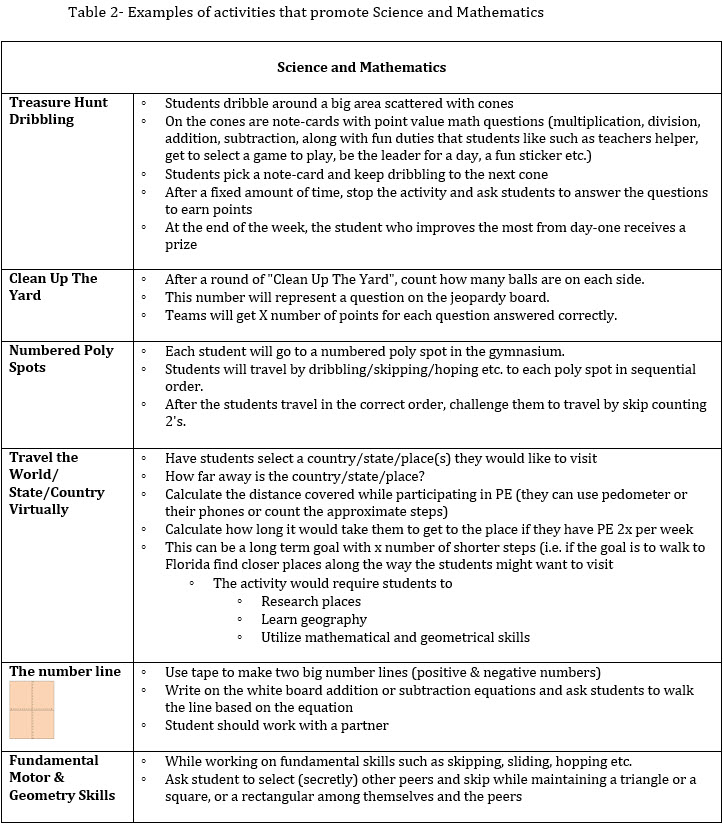More and more states are adopting the Common Core State Standards (CCSS) while the student population, in the United States, is rapidly becoming more diverse. The CCSS aim to prepare students for College and Career Readiness (CCR). As the new direction of today’s educational reform, CCR is defined as the preparation of high school graduates to enter college courses and/or workforce-training programs (Mills, 2012) successfully. The CCSS intend to set consistent expectations for all students across states. Individual districts or schools however, are still responsible for designing content, instructional strategies and assessments in order to meet these expectations.
Literacy and mathematical skills are a primary focus of the CCSS and technical subjects -physical education and art – are expected to support and promote such skills. Thus, the CCSS evoke the need for a more cross-disciplinary educational approach requiring more explicit instructions regarding reading, writing, speaking, listening as well as critical thinking and problem solving skills, by all educators. In other words, infusing the above components into physical education programs is no longer a choice but rather a requirement.
Commonly, most high-quality physical education programs do provide opportunities for students to develop motor, cognitive and social skills (Sibley & Etnier 2003; Etnier et al., 1997) along with problem solving, collaboration and communication skills. The expectation implicit in CCSS however, of physical education promoting and supporting mathematics and literacy, puts a greater challenge upon PE programs. Already many physical educators are battling to keep larger size classes of students appropriately engaged in health-enhancing levels of physical activity.
This article points out how a high-quality physical education programs could -if it is not doing so already – promote and support CCR and meet CCSS. With the implementation of commonly used methods and approaches, and the willingness to re-think physical education programs with a multidisciplinary lens, the CCSS could be an attainable challenge.
Physical Education Content and Instructional Methods
We would all agree that two primary components of a high-quality physical education program are the choice of content and instructional methods. What the content taught in physical education should be however, has been a point of longstanding debate among physical educators and curriculum specialists.
Many physical educators believe that involving students in the selection of content can increase student engagement and motivation (Bron & Veugelers, 2014). Moreover, obtaining students’ input as to what they value and consider worth learned can alleviate a great number of behavioral issues, commonly observed among unengaged and uninterested students. Ultimately, student input can increase accountability and empowerment because it conveys control to students over their learning. With such knowledge in mind and the CCSS requirement of teaching students how to communicate, cooperate and collaborate, it makes sense for teachers to start off by involving students. Why not present the CCSS challenge and ask students to be part of finding solutions to this challenge?

Content – what is taught – in a physical education program is important. However, teaching methods – how the content is delivered – is equally, if not more important. Using a variety of teaching methods, particularly those that are student-centered rather than teacher-centered, provides opportunities for students to practice CCSS literacy skills (reading, speaking, listening and writing skills), as well as their problem solving skills. A few good examples of commonly used teaching methods in physical education include the tactical approach, practice style and reciprocal style. All three of these teaching methods create a self-directed learning environment for students allowing them to be more independent, but they can also be designed to encourage collaboration among students.
Tactical Approach: For example, when a tactical approach (Griffin & Butler 2005) is utilized, students are given a problem to solve (e.g., find a way to score as many points as possible, or find a way to keep the ball up in the air, or find a way to pass the ball to all your teammates). These might seem easy problems yet they teach students the thinking process to find a solution to a problem. This approach encourages them to initiate collaboration and cooperation with other students in the class or group to figure out the solution to the problem.
Practice Style: In the practice teaching styles (Mosston & Ashworth 1994), students are expected to independently or in small groups, read the Task Instruction Card, which could also be written as a problem, and figure out what needs to be completed. The practice style promotes reading as students need to read the Task Instruction Card, listening as they might have to listen to another student read the Task Instruction Card, and speaking as they have to discuss with others how they will complete the task. Furthermore, it has the potential of promoting writing skills by asking students to summarize process taken for completing the task.
Reciprocal Style: The reciprocal teaching style (Mosston & Ashworth 1994) is similar to the practice style but incorporates a peer-to-peer teaching element that gives students excellent opportunities to hone their communication skills and show respect for one another. As students directly engage in cooperation and collaboration they develop communication and interpersonal skills, which are all CCR expectations and important 21st century skills.
Table 1 and Table 2 present examples of activities supporting literacy and mathematic skills.


Assessment
Past assessment practices in physical education primarily used teacher observations to grade or identify student talents (Lo?pez-Pastor et al., 2013) and place them at the appropriate level of ability. Today, the notion of assessment has evolved (Lund & Tannehill, 2010) into being a broader part of the teaching process, and currently the CCSS brings assessment to the forefront of educational reform. Assessment data driven instruction is the latest expectation of physical educators and all teachers in general.
Assessment practices are another part of the teaching process that some physical educators are hesitant to fully embrace (Matanin & Tannehill, 1994; Strand & Scantling, 1994; Collier, 2011). Assessments many times are perceived as tasks that take away time from physical activity. This is, admittedly, a challenge for physical educators with large size classes. It is not, however, an impossible task and it is a vital task for holding student accountable (Rink, 2010) and uphold physical education’s academic reputation (Young, 2011). With careful, creative, and intentional planning, assessments can be utilized with minimum amount of downtime.
Data Driven Instruction: CCSS expect instruction to be guided by data and student leaning outcomes to be formally monitored. Assessments can be and have been used to determine current levels of student ability, and have been used to provide students and teachers with data about how well both parts – student and teachers – are doing. Moreover, assessments can provide data that helps evaluate mandated standards (LoBianco, 2013) and program effectiveness. A pre-assessment at the beginning of a unit can indicate strengths, weaknesses, what students know, and what they don’t know. This pre-assessment helps avoid content redundancy and student boredom that occurs by teaching the same content over and over again. A systematic formative assessment approach can monitor student-learning outcomes, provide a clearer view of possible content gaps, and identify areas of student confusion.
Formative and Summative: Assessment practices – both formative and summative – need to be an integral part of any physical education program (Fisette & Frank, 2012). A combination of traditional and performance-based assessment methods allow students to demonstrate their cognitive, emotional and physical capabilities (Mauch, 2005). Assessment tools ought to be designed incorporating the principles of multiple intelligence theory (Bloom et al., 1956) and using the differentiated instruction approach (Tomlinson, 2003) to enable students to demonstrate learning in a fashion that aligns with their learning style.
Assessment tools: Assessment tools such as checklists and rubrics with clear criteria can easily be used as self and peer assessments. They work quite effectively with large size classes and the student-centered teaching styles presented above. Peer assessments compel students to read the criteria, compare and contrast the criteria with the observed performance and then make an evaluative decision about what was observed; a process that addresses a number of the literacy CCSS. Even the common “teacher observation” can be an effective assessment tool in monitoring students’ progress and informing teacher-instructions. However, clear criteria must be predetermined and these informal observations systematically recorded. As long as clear and consistent criteria define what each symbol represents, a quick and simple system of a check, check plus, or check minus can provide data on student-performance and teacher-instructions (Wiliam et al., 2004).
Professional Development
One might wonder what professional development has to do with CCSS, however any given standards are only as good as the teachers who are teaching towards them. Expecting or encouraging a culture of professional development among physical educators improves the effectiveness of any physical education program (James, 2005) and can make the process of teaching toward CCSS less challenging.
School districts should be expected to provide opportunities for worthwhile professional development for physical educators. New ideas for physical activities, teaching methods and techniques for incorporating technology, assessments and other trends of the field are just a few areas for development that will benefit physical educators. Additionally, physical educators are encouraged to collaborate with teachers of other disciplines and implement practices such peer-observations and peer-feedback. A multidisciplinary collaboration on lesson planning and other instructional strategies could greatly enhance teaching effectiveness among all teachers (Keay 2006).
Physical educators can more successfully re-enforce and support math and literacy skills already taught if they are aware of them. Moreover, students can see the continuity and experience the impact of a good collaboration among the different disciplines. Meeting the CCSS and preparing students for CCR reflects a program’s effectiveness. But program effectiveness is a byproduct of teacher collaboration, communication, assessment, constant reflection and instructional adjustment.
Conclusion
In the past, an aligning thread within the discipline that connected physical education content, teaching and assessment methods, could have been enough to serve as a foundation for a physical education program. Today however, with the CCSS guiding educational reform, a more multidisciplinary approach needs to be embraced by all educators if we are to help the new generation of students meet the demands of the 21st century.
When such collaborative efforts are reached, CCR and CCSS are more likely to be accomplished. As physical educators, we know that team efforts work better than individual efforts. Educators of all subject areas should no longer work in silos. All of us – teachers, administrators, and students – need to open up our classrooms, gymnasiums and thinking toward more collaborative approaches. The generation of the 21st century requires knowledge and skills that are better taught with an interconnected approach.
References
Bloom, B.S. (Ed.). Engelhart, M.D., Furst, E.J., Hill, W.H., Krathwohl, D.R. (1956). Taxonomy of Educational Objectives, Handbook I: The Cognitive Domain. New York: David McKay Co Inc.
Bron, J., & Veugelers, W. (2014). Why we need to involve our students in curriculum design: five arguments for student voice. Curriculum & Teaching Dialogue, 16 (1), 125-140.
Collier, D. (2011). The marginalization of physical education: Problems and solutions – Part 2. Increasing the value of physical education: The role of assessment. Journal of Physical Education, Recreation & Dance, 82(7), 38-41.
Etnier, J.L., Salazar, D.M.W., Landers, S.J. Petruzello, M.H., & Nowell, P. (1997). The influence of physical fitness and exercise upon cognitive functioning: a meta-analysis. Journal of Sport & Exercise Psychology, 19, 249-277.
Fisette, J.L., & Franck, D.M. (2012). How Teachers Can Use PE Metrics for Formative Assessment. Journal of Physical Education, Recreation & Dance, 83(5), 23-26, 34
Griffin, L., L. & Butler, J. I. (2005). Teaching Games for Understanding: Theory, Research, and Practice. Champaign, III. Human Kinetics.
James, M. (2005) Insights on teacher learning from the Teaching and Learning Research Programme (TLRP). Research Papers in Education, 20(2), 105-108.
Keay, J. (2006). Collaborative learning in physical education teachers’ early-career professional development. Physical Education and Sport Pedagogy, 11 (3), 285- 305.
LoBianco, J. (2013). The advocacy responsibility lies within. Strategies, 26(2), 37-38.
Lo?pez-Pastor, V., Kirk, D., Lorente-Catalan, E., MacPhail, A., & Macdonald, D. (2013). Alternative assessment in physical education: A review of international literature. Sport, Education and Society, 18(1), 57-76.
Lund, J., & Tannehill, D. (2010). Standards-based physical education curriculum development (2nd ed.). Boston, MA: Jones & Bartlett.
Matanin, M., & Tannehill, D. (1994). Assessment and grading in physical education. Journal of Teaching in Physical Education, 13(4), 395-405.
Mosston, M., & Ashworth, S. (1994). Teaching physical education (4th Ed.). Macmillan, New York.
Mauch, J. (2005). Performance Based Assessment vs. Traditional Assessments in the Science Classroom. Retrieve from http://www.csun.edu/~jcm68622/695b/comps/peformanceassessment.pdf
Mills, D. (2012). College and career readiness toolkit. Center for Occupational Research and Development (CORD), 1-154.
Rink, J. E. (2010). Teaching physical education for learning (6th ed.). New York, NY: McGraw-Hill.
Sibley, B.A., & Etnier, J.L. (2003). The relationship between physical activity and cognition in children: a meta-analysis. Pediatric Exercise Science, 15, 243-256.
Strand, B. B., & Scantling, E. E. (1994). An analysis of secondary student preferences towards physical education. The Physical Educator, 51(3), 119-129.
Tomlinson, C. (2003). Fulfilling the Promise of the Differentiated Classroom. Alexandria, VA: Association for Supervision and Curriculum Development
Wiliam, D., Lee, C., Harrison, C., & Black, P. (2004). Teachers developing assessment for learning: Impact on student achievement. Assessment in Education, 11, 49-65
Young, S. (2011). A survey of student assessment practice in physical education: Recommendations for grading. Strategies, 24(6), 24-26.
